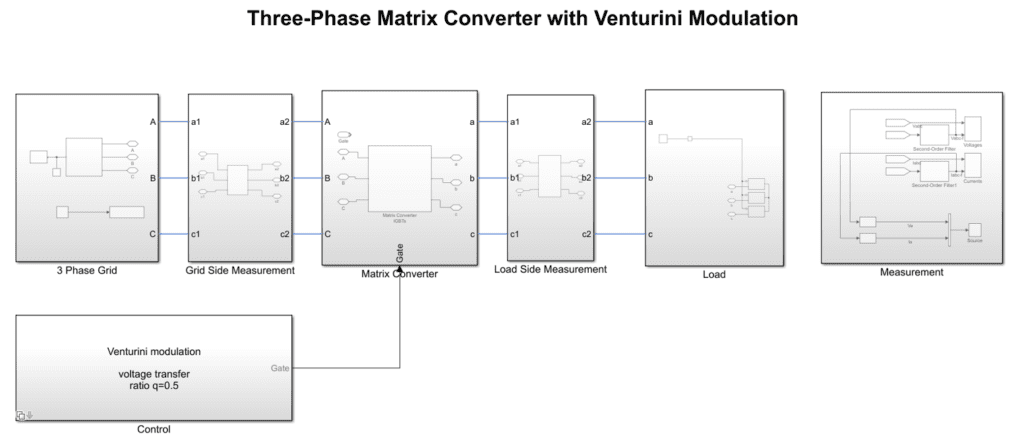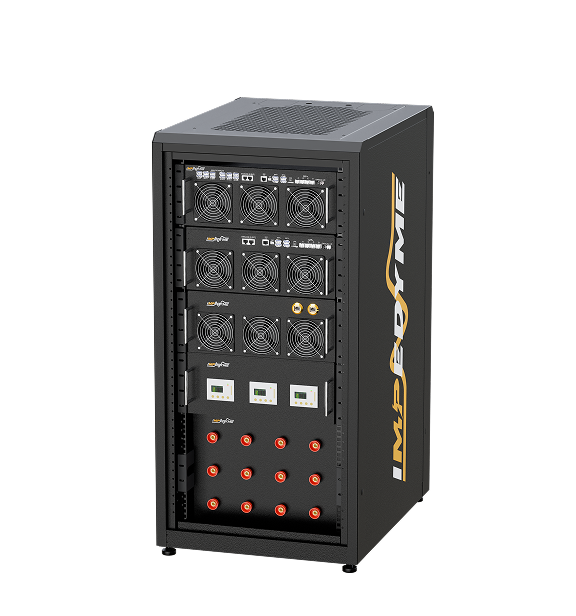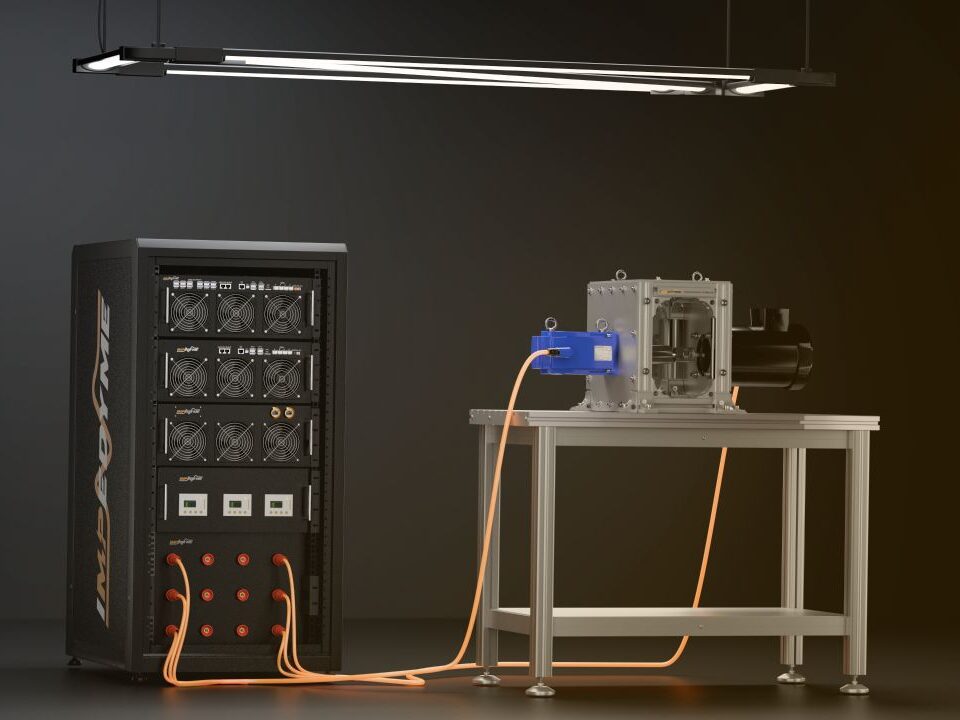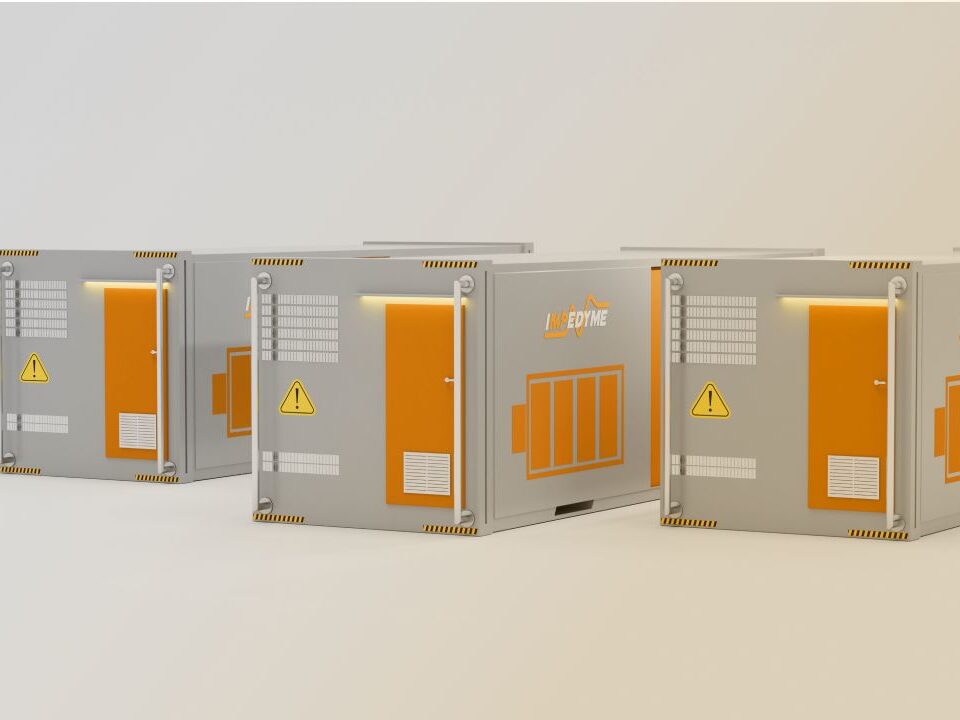
-
 Induction Motor
Induction Motor
-
 Automotive Electrical System Simulation
Automotive Electrical System Simulation
-
 DC/DC Bidirectional Converter
DC/DC Bidirectional Converter
-
 PWM Control for Brushless DC
PWM Control for Brushless DC
-
 BLDC Motor Control and Drive Simulation
BLDC Motor Control and Drive Simulation
-
 Electric Vehicle Fast Charger Simulation
Electric Vehicle Fast Charger Simulation
-
 DFIG Wind Turbine Simulation
DFIG Wind Turbine Simulation
-
 Dual Active Bridge
Dual Active Bridge
-
 EV Dynamometer Test Environment Simulation
EV Dynamometer Test Environment Simulation
-
 Electric Vehicle Simulation
Electric Vehicle Simulation
-
 Three-Phase Grid-Connected Inverter Using Direct-Q…
Three-Phase Grid-Connected Inverter Using Direct-Q…
-
 Three-Phase Grid-Connected Solar Photovoltaic
Three-Phase Grid-Connected Solar Photovoltaic
-
 Grid-Connected Rectifier
Grid-Connected Rectifier
-
 Grid-Tied Inverter System
Grid-Tied Inverter System
-
 Torque Control in a Hybrid Excitation Synchronous …
Torque Control in a Hybrid Excitation Synchronous …
-
 Wye-Delta Starting Circuit
Wye-Delta Starting Circuit
-
 IPMSM-Based Axle-Drive
IPMSM-Based Axle-Drive
-
 Simplified Parallel Hybrid Electric Vehicle
Simplified Parallel Hybrid Electric Vehicle
-
 Simplified Series Hybrid Electric Vehicle
Simplified Series Hybrid Electric Vehicle
-
 Series-Parallel Hybrid Electric Vehicle
Series-Parallel Hybrid Electric Vehicle
-
 Three-Phase Matrix Converter Simulation
Three-Phase Matrix Converter Simulation
-
 Venturini Modulation for Three-Phase Matrix Conver…
Venturini Modulation for Three-Phase Matrix Conver…
-
 Microgrid Frequency Regulation Using Vehicle-to-Gr…
Microgrid Frequency Regulation Using Vehicle-to-Gr…
-
 Three-Phase Modular Multilevel Converter
Three-Phase Modular Multilevel Converter
-
 Field-Oriented Control
Field-Oriented Control
-
 Interior Permanent Magnet Synchronous Generator
Interior Permanent Magnet Synchronous Generator
-
 Permanent Magnet Synchronous Machine
Permanent Magnet Synchronous Machine
-
 PMSM Rotor Angular Velocity
PMSM Rotor Angular Velocity
-
 PMSM-Based Electrical Traction Drive
PMSM-Based Electrical Traction Drive
-
 Maximum Power Point Tracking
Maximum Power Point Tracking
-
 Six-Phase Permanent Magnet Synchronous Machine
Six-Phase Permanent Magnet Synchronous Machine
-
 Synchronous Machine-Based Electrical Drive Simulat…
Synchronous Machine-Based Electrical Drive Simulat…
-
 Single-Stage Solar Inverter
Single-Stage Solar Inverter
-
 Three-Phase Cycloconverter Simulation
Three-Phase Cycloconverter Simulation
-
 Totem-Pole PFC Simulation
Totem-Pole PFC Simulation
-
 Twelve-Pulse Thyristor Rectifier
Twelve-Pulse Thyristor Rectifier
-
 Two-Wheeler On-Board Charger
Two-Wheeler On-Board Charger
-
 Vienna Rectifier Simulation
Vienna Rectifier Simulation
-
 High-Voltage Direct Current
High-Voltage Direct Current
-
 Wireless Power Transfer
Wireless Power Transfer

Comprehensive Documentation for Venturini Modulation for Three-Phase Matrix Converter Simulation
Table of Contents
- 1 Comprehensive Documentation for Venturini Modulation for Three-Phase Matrix Converter Simulation
- 1.1 Introduction
- 1.2 System Overview
- 1.2.1 What is a Three-Phase Matrix Converter?
- 1.2.2 Purpose of the Simulation
- 1.3 Key Features
- 1.3.1 Venturini Modulation Technique
- 1.3.2 Bidirectional Power Flow Capability
- 1.3.3 Frequency and Voltage Control
- 1.4 Simulation Objectives
- 1.5 Technical Description
- 1.5.1 System Configuration
- 1.5.2 Control Methodology
- 1.6 Advantages of Matrix Converters
- 1.7 Applications
- 1.7.1 Renewable Energy Systems
- 1.7.2 Industrial Motor Drives
- 1.7.3 Aerospace and Defense
- 1.7.4 Electric Vehicles (EVs)
- 1.7.5 Marine and Offshore Applications
- 1.7.6 Power Quality Improvement
- 1.7.7 Research and Development
- 1.7.8 Energy Storage Systems (ESS)
- 1.8 Simulation Benefits
- 1.9 Summary
- 1.10 Future Enhancements
- 1.10.1 Induction Motor
- 1.10.2 Automotive Electrical System Simulation
- 1.10.3 DC/DC Bidirectional Converter
- 1.10.4 PWM Control for Brushless DC
Introduction
Matrix converters are direct AC-AC power conversion systems that eliminate the need for DC-link energy storage, providing compact, efficient, and bidirectional power conversion. This project simulates a three-phase matrix converter using Venturini modulation, a widely used control technique that ensures sinusoidal output waveforms, reduced harmonic distortion, and optimized voltage transfer ratio.

System Overview
What is a Three-Phase Matrix Converter?
A three-phase matrix converter directly connects the input and output through an array of bidirectional switches, enabling flexible frequency and voltage conversion without an intermediate DC-link. Key advantages include:
✔ Compact design with fewer passive components.
✔ Full four-quadrant operation for bidirectional power flow.
✔ Improved efficiency and reduced weight.
Purpose of the Simulation
This simulation aims to:
✔ Implement and analyze Venturini modulation in a three-phase matrix converter.
✔ Evaluate voltage transfer ratio and waveform quality under different operating conditions.
✔ Assess harmonic performance and efficiency of the converter system.
Key Features
Venturini Modulation Technique
✔ Ensures sinusoidal output voltages with reduced harmonics.
✔ Controls input power factor and voltage transfer ratio efficiently.
➡️ HIL/PHIL Benefit: Enables real-time implementation and testing of Venturini modulation.
Bidirectional Power Flow Capability
✔ Supports regenerative operation for energy-efficient systems.
✔ Ideal for motor drives, renewable energy, and industrial applications.
➡️ HIL/PHIL Benefit: Provides real-time validation for bidirectional energy management.
Frequency and Voltage Control
✔ Enables flexible control over output frequency and voltage.
✔ Maintains grid compliance and stability in renewable applications.
➡️ HIL/PHIL Benefit: Ensures optimal performance in dynamic grid conditions.
Performance Optimization: Ensures optimal performance of matrix converters under real-world conditions.
Energy Efficiency: Helps design energy-efficient systems with reduced energy losses.
Reliability and Durability: Validates the durability and reliability of matrix converters, reducing the risk of failures.
Regulatory Compliance: Ensures compliance with industry standards and regulations for safety and performance.
Simulation Objectives
This simulation helps evaluate:
✔ Performance of Venturini modulation in AC-AC conversion.
✔ Voltage and frequency control capabilities of the matrix converter.
✔ Power quality, efficiency, and harmonic distortion levels.
➡️ HIL/PHIL Benefit: Provides real-time validation for industrial applications before hardware deployment.
Technical Description
System Configuration
- Input: Three-phase AC supply.
- Power Conversion: Matrix converter with nine bidirectional switches.
- Control Algorithm: Venturini modulation for optimized voltage and frequency control.
- Output: Three-phase AC with variable voltage and frequency.
Control Methodology
- Venturini Modulation: Generates PWM control signals for bidirectional switches.
- Power Factor Correction: Adjusts input power factor to maximize efficiency.
- Harmonic Reduction: Ensures smooth and sinusoidal waveforms at the output.
➡️ HIL/PHIL Benefit: Enables real-time validation of control strategies.
Advantages of Matrix Converters
✔ Eliminates bulky DC-link capacitors for a more compact design.
✔ Enables four-quadrant operation for regenerative applications.
✔ Reduces harmonics and enhances waveform quality.
➡️ HIL/PHIL Benefit: Provides real-time tuning of modulation schemes.
Applications
Renewable Energy Systems
- Wind Turbines: Matrix converters with Venturini modulation are used in wind energy systems to convert variable-frequency AC power from the generator into grid-compatible AC power, improving energy efficiency and grid stability.
- Solar Power Systems: These converters are used in solar inverters to manage power flow between solar panels, batteries, and the grid, ensuring efficient energy conversion.
Industrial Motor Drives
- Variable Frequency Drives (VFDs): Matrix converters with Venturini modulation are used in VFDs to control the speed of AC motors, providing precise and efficient operation in industrial machinery.
- Pump and Fan Drives: These converters are used in pumps and fans to improve energy efficiency and process control, reducing energy consumption in industrial plants.
Aerospace and Defense
- Aircraft Power Systems: Matrix converters with Venturini modulation are used in aircraft to manage power flow between generators, batteries, and onboard systems, ensuring reliable operation under extreme conditions.
- Military Vehicles: These converters are used in electric and hybrid military vehicles for efficient power conversion and energy management in harsh environments.
Electric Vehicles (EVs)
- On-Board Chargers: Matrix converters with Venturini modulation are used in EV on-board chargers to convert AC power from the grid into DC power for battery charging, improving charging efficiency and reliability.
- Traction Drives: These converters are used in EV traction drives to provide efficient and precise control of motor speed and torque, enhancing vehicle performance.
Marine and Offshore Applications
- Shipboard Power Systems: Matrix converters with Venturini modulation are used in electric and hybrid ships to manage power flow between generators, batteries, and onboard systems, ensuring efficient and reliable operation.
- Offshore Platforms: These converters are used in offshore oil and gas platforms to ensure stable power supply and efficient energy management in harsh conditions.
Power Quality Improvement
- Active Power Filters (APF): Matrix converters with Venturini modulation are used in APFs to mitigate harmonics and improve power quality, ensuring stable and efficient operation of industrial power systems.
- Static Synchronous Compensators (STATCOM): These converters are used in STATCOMs for reactive power compensation, improving voltage regulation and grid stability.
Research and Development
- Prototype Testing: Simulations are used to test and validate matrix converter prototypes with Venturini modulation, reducing the need for physical testing and accelerating development.
- Control Strategy Development: Simulations help develop and optimize control algorithms for matrix converters, ensuring efficient and reliable operation.
- Fault Analysis: Simulations help study the behavior of matrix converters under fault conditions, improving system reliability and safety.
Energy Storage Systems (ESS)
- Battery Energy Storage: Matrix converters with Venturini modulation are used in battery energy storage systems to manage charging and discharging, optimizing power flow and grid stability.
- Grid Support: These converters provide grid services like frequency regulation and voltage support, enhancing grid stability and reliability.
➡️ HIL/PHIL Benefit: Allows pre-deployment testing for different use cases.
Simulation Benefits
With this simulation, users can:
✔ Analyze the impact of Venturini modulation on output voltage and frequency.
✔ Optimize switch control strategies for improved efficiency.
✔ Evaluate total harmonic distortion (THD) and power quality improvements.
➡️ HIL/PHIL Benefit: Ensures seamless transition from simulation to real-world implementation.
Summary
The Venturini Modulation for Three-Phase Matrix Converter Simulation provides a structured framework for studying AC-AC conversion, voltage control, and harmonic performance. Impedyme’s HIL and PHIL solutions enhance the development process:
| Development Stage | Impedyme’s Contribution |
|---|---|
| Modulation Optimization | Real-time HIL validation of Venturini control strategies |
| Power Quality Analysis | PHIL-based testing of waveform characteristics |
| Efficiency Assessment | Real-time evaluation of voltage transfer ratio |
| Full-System Validation | PHIL integration for grid and industrial applications |
Future Enhancements
✔ Integration of predictive control techniques for dynamic applications.
✔ Optimization of switching strategies for further efficiency improvements.
✔ Advanced real-time monitoring for adaptive control in smart grids.
The Venturini Modulation for Three-Phase Matrix Converter Simulation serves as a critical tool for AC-AC power conversion research and development. With Impedyme’s HIL/PHIL solutions, engineers can optimize converter performance, reduce harmonics, and validate control strategies before real-world deployment.






